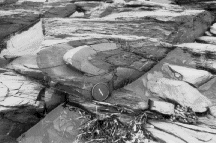|
|
10. Folds and Folding
 Ask
a structural geologist or any geologist for that matter about their favorite
structure and chances are that they will say folds. If you have seen a
fold in the field you will have marveled at its appearance. Let's face
it, it is pretty unbelievable that "hard rocks" are able to change shape
in such a dramatic way (Figure). In simple terms, a fold is a structural
feature that is formed when planar surfaces are bent or curved. In fact,
if such surfaces are not available (e.g., bedding, cleavage, inclusions)
you will not see a fold even though the rock is deformed. Folding represents
ductile deformation because there is no mesoscopic evidence for fracturing
and the deformation is (heterogeneously) distributed over the entire structure.
Some fracturing may occur in places, but processes such as grain-boundary
sliding, kinking, dissolution and crystal plasticity are dominant. Looking
at a fold from a kinematic perspective, you may realize that the strain
in this structure cannot be the same everywhere. We recognize distinct
sections in a fold, such as the hinge area and the limbs, the inner arc
and the outer arc, which each reflect different strain histories. Whereas
much of our discussion in this chapter focuses on mesoscale folds, you
will find that folds occur on all scales, from mm-size or smaller microfolds
in thin sections (see book cover) to a single large folds that occupy entire
mountains. Why do folds exist, how do rocks do it, what does folding mean
for regional analysis? Well, these and many other questions were first
asked quite some time ago and much of what we know today about folds and
folding was established well before the 1980's. The geometry of folds tells
us something about, for example, the conditions of stress and strain, which
in turn provides critical information about the deformation history of
a deformed area. Much of the work in more recent years presents refinements
of some of this earlier work, in particular we use more sophisticated numerical
and experimental approaches. Yet, the fundamental observations remain essentially
in tact, and therefore we will mainly look at some of these first principles
of folding in this chapter, and their application in structural analysis.
Ask
a structural geologist or any geologist for that matter about their favorite
structure and chances are that they will say folds. If you have seen a
fold in the field you will have marveled at its appearance. Let's face
it, it is pretty unbelievable that "hard rocks" are able to change shape
in such a dramatic way (Figure). In simple terms, a fold is a structural
feature that is formed when planar surfaces are bent or curved. In fact,
if such surfaces are not available (e.g., bedding, cleavage, inclusions)
you will not see a fold even though the rock is deformed. Folding represents
ductile deformation because there is no mesoscopic evidence for fracturing
and the deformation is (heterogeneously) distributed over the entire structure.
Some fracturing may occur in places, but processes such as grain-boundary
sliding, kinking, dissolution and crystal plasticity are dominant. Looking
at a fold from a kinematic perspective, you may realize that the strain
in this structure cannot be the same everywhere. We recognize distinct
sections in a fold, such as the hinge area and the limbs, the inner arc
and the outer arc, which each reflect different strain histories. Whereas
much of our discussion in this chapter focuses on mesoscale folds, you
will find that folds occur on all scales, from mm-size or smaller microfolds
in thin sections (see book cover) to a single large folds that occupy entire
mountains. Why do folds exist, how do rocks do it, what does folding mean
for regional analysis? Well, these and many other questions were first
asked quite some time ago and much of what we know today about folds and
folding was established well before the 1980's. The geometry of folds tells
us something about, for example, the conditions of stress and strain, which
in turn provides critical information about the deformation history of
a deformed area. Much of the work in more recent years presents refinements
of some of this earlier work, in particular we use more sophisticated numerical
and experimental approaches. Yet, the fundamental observations remain essentially
in tact, and therefore we will mainly look at some of these first principles
of folding in this chapter, and their application in structural analysis.